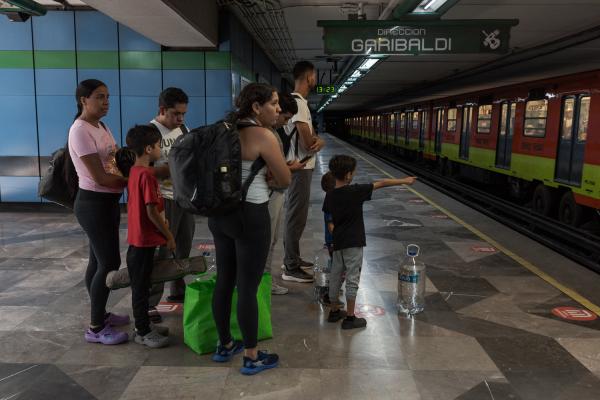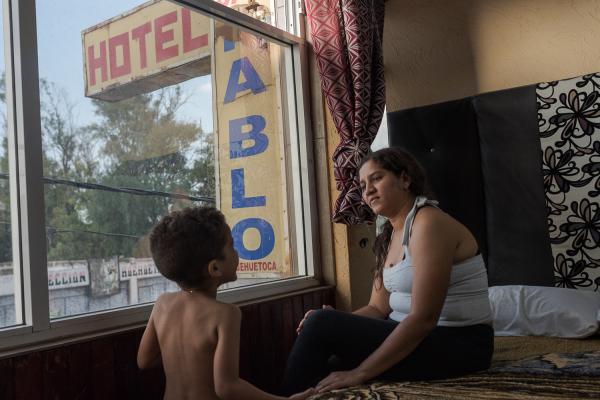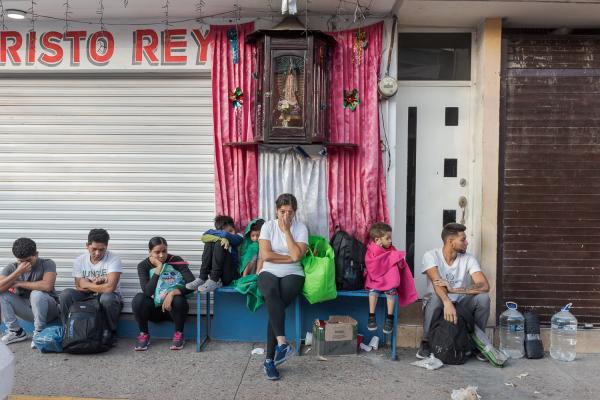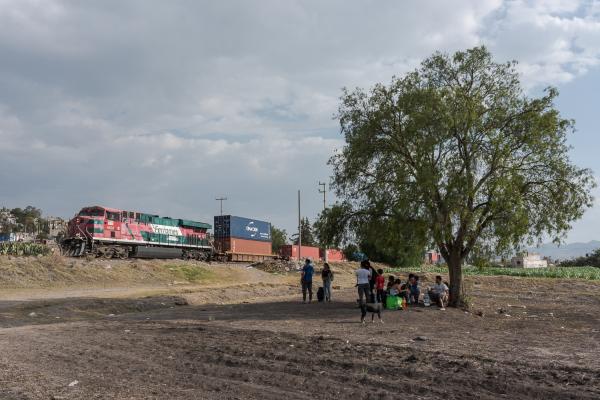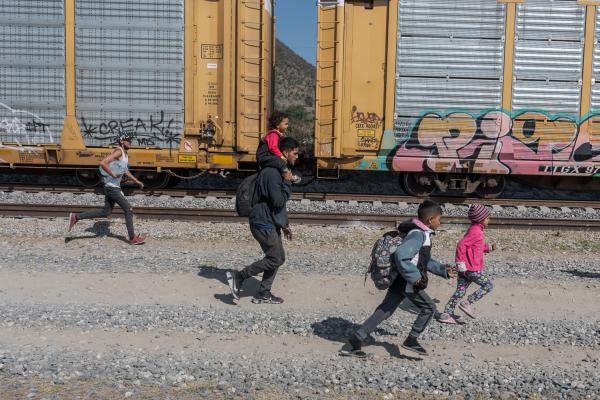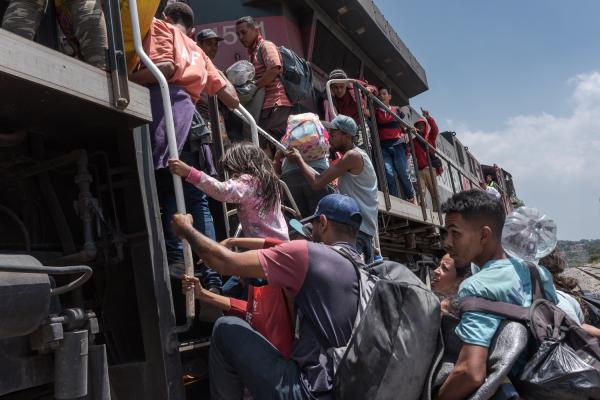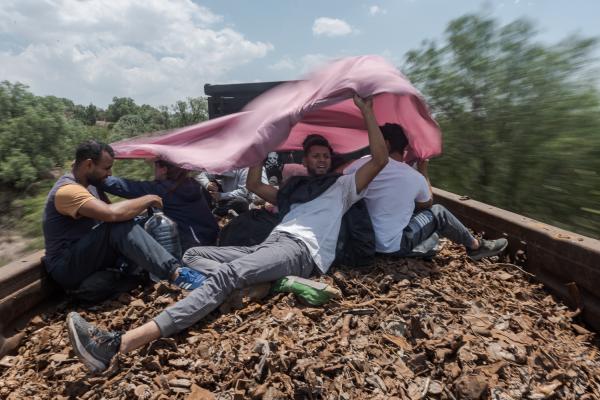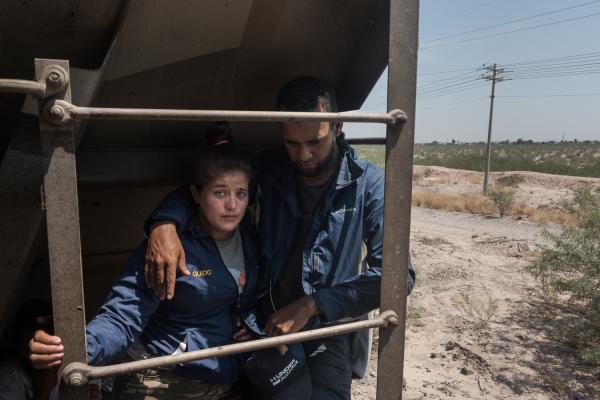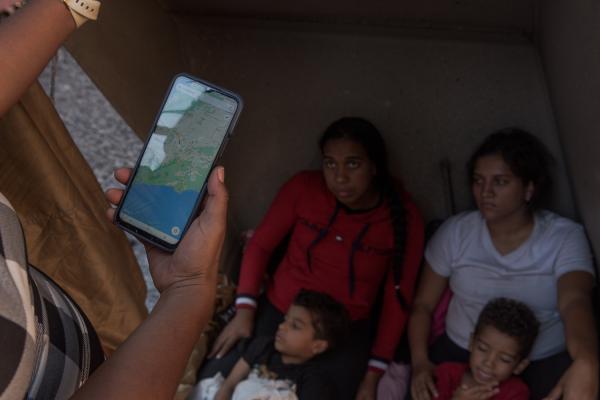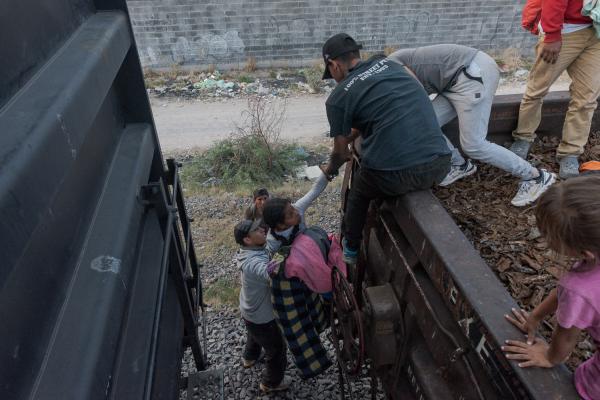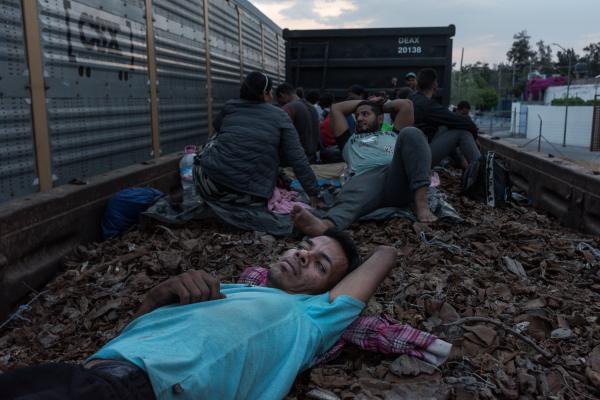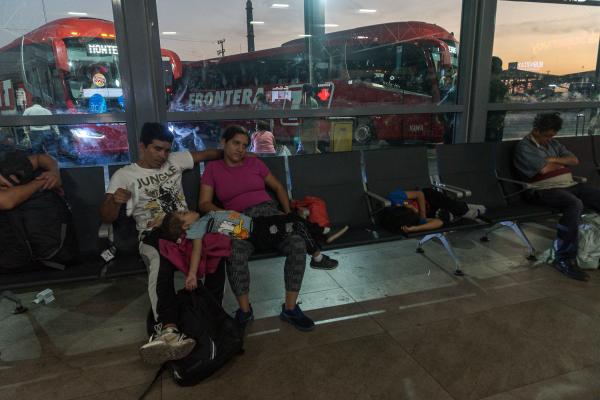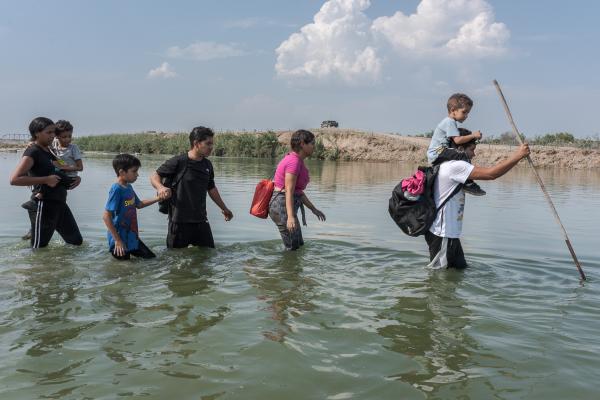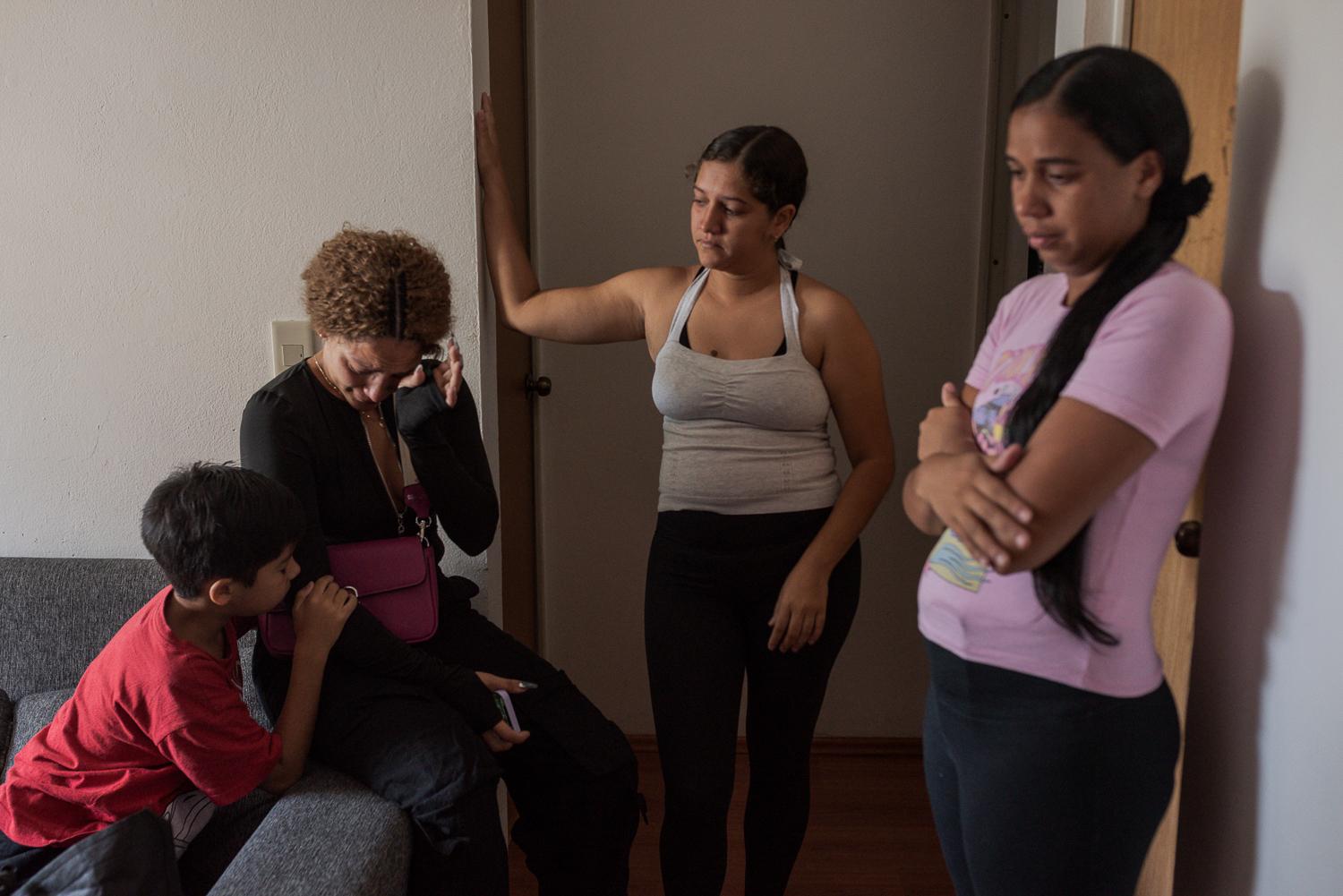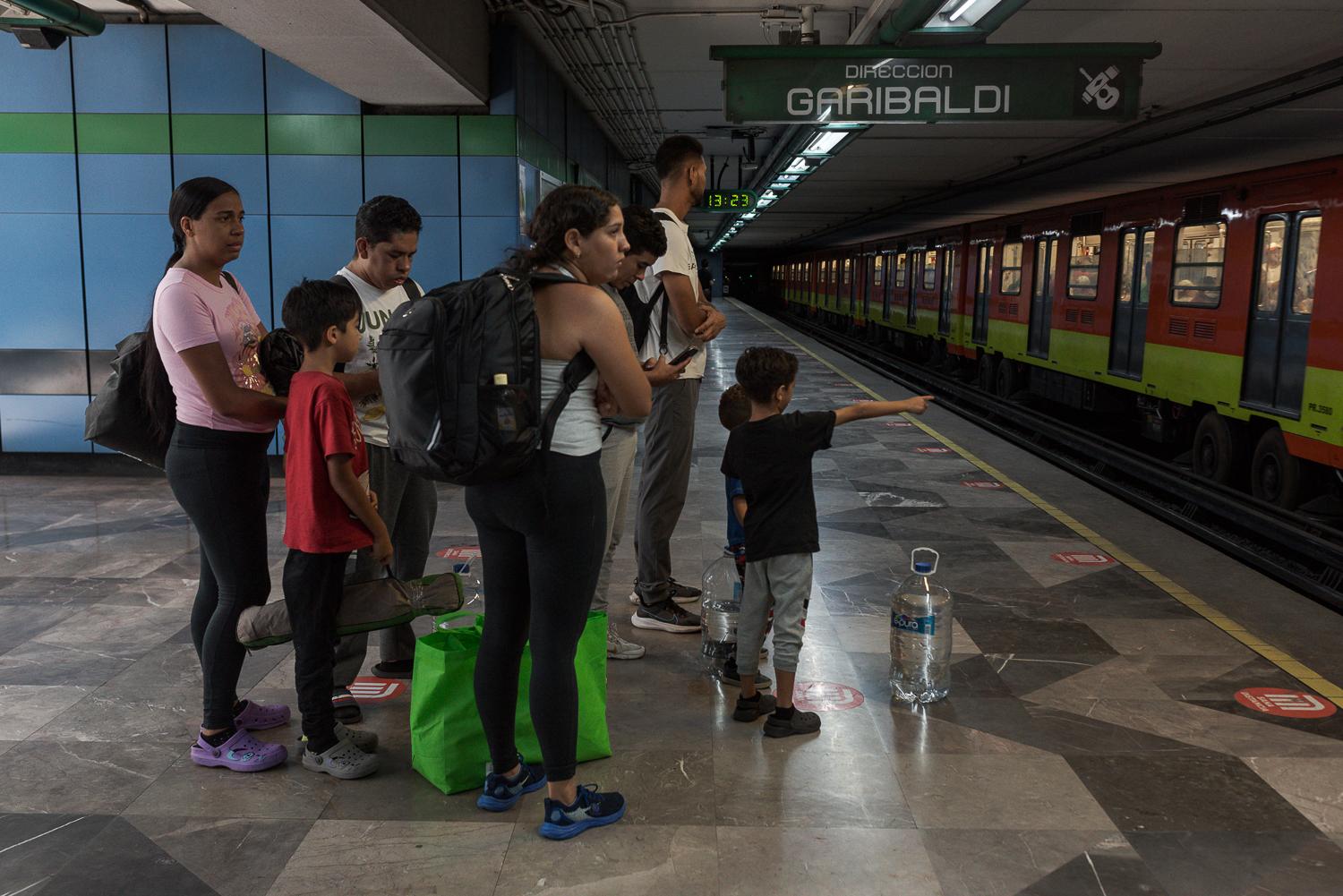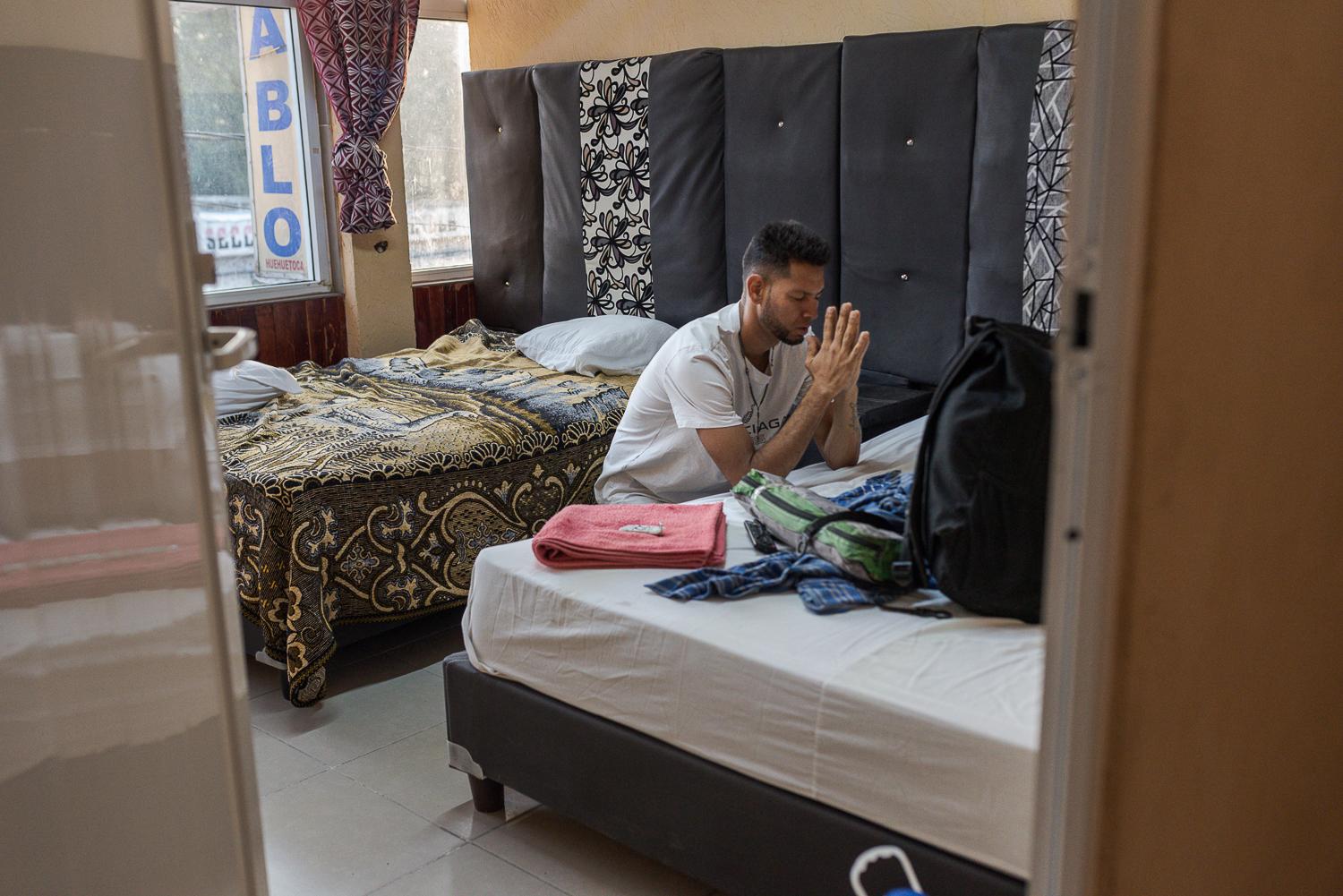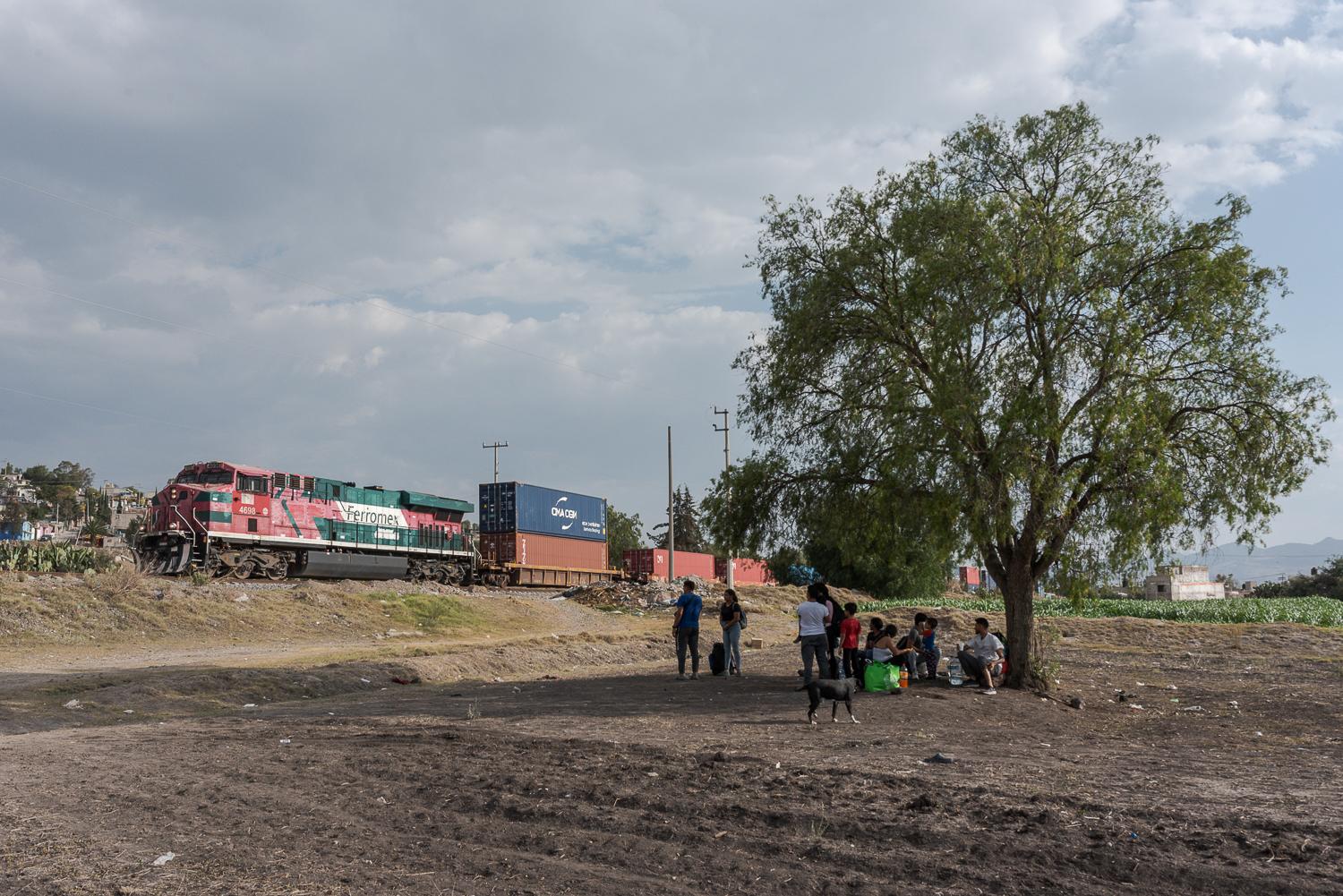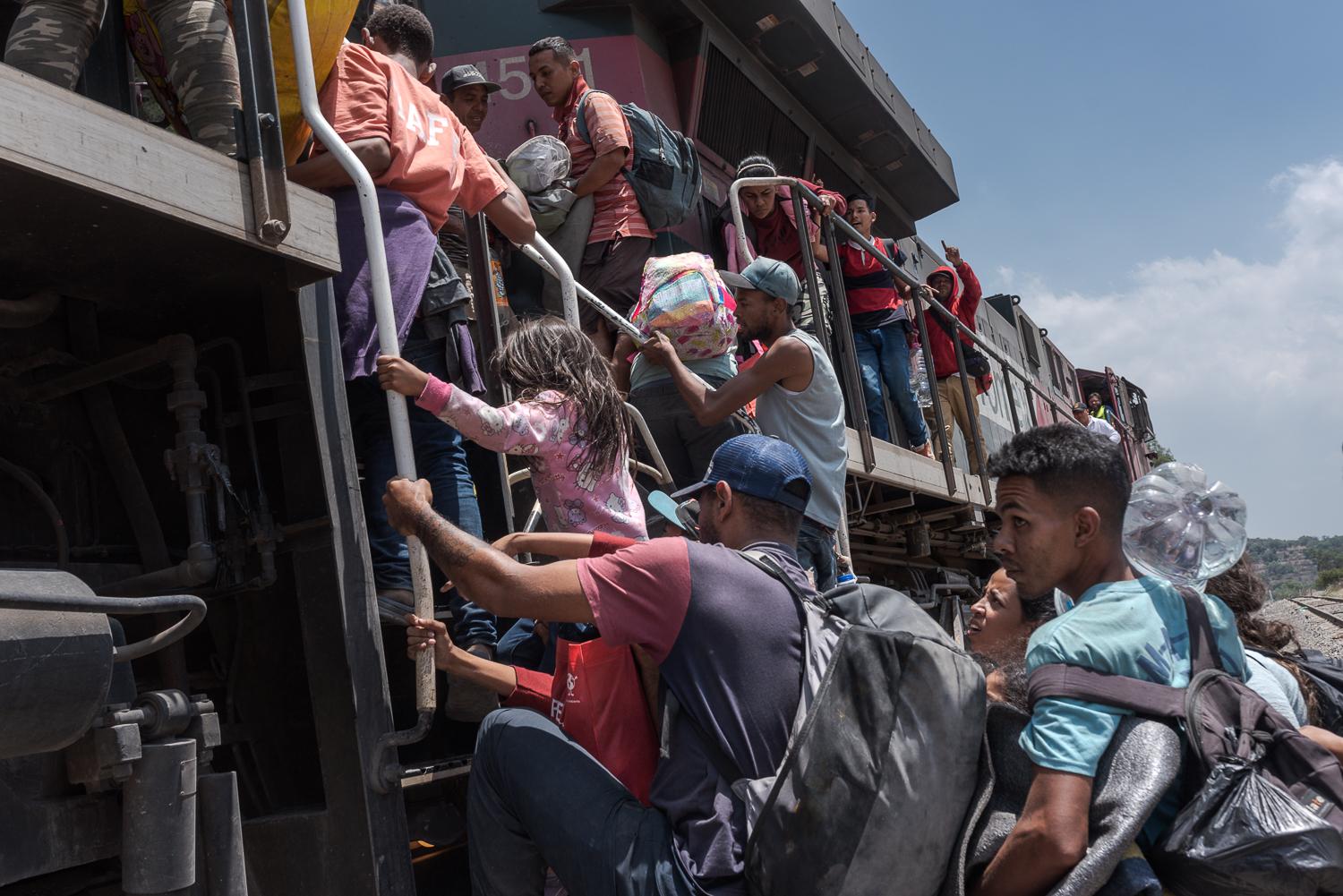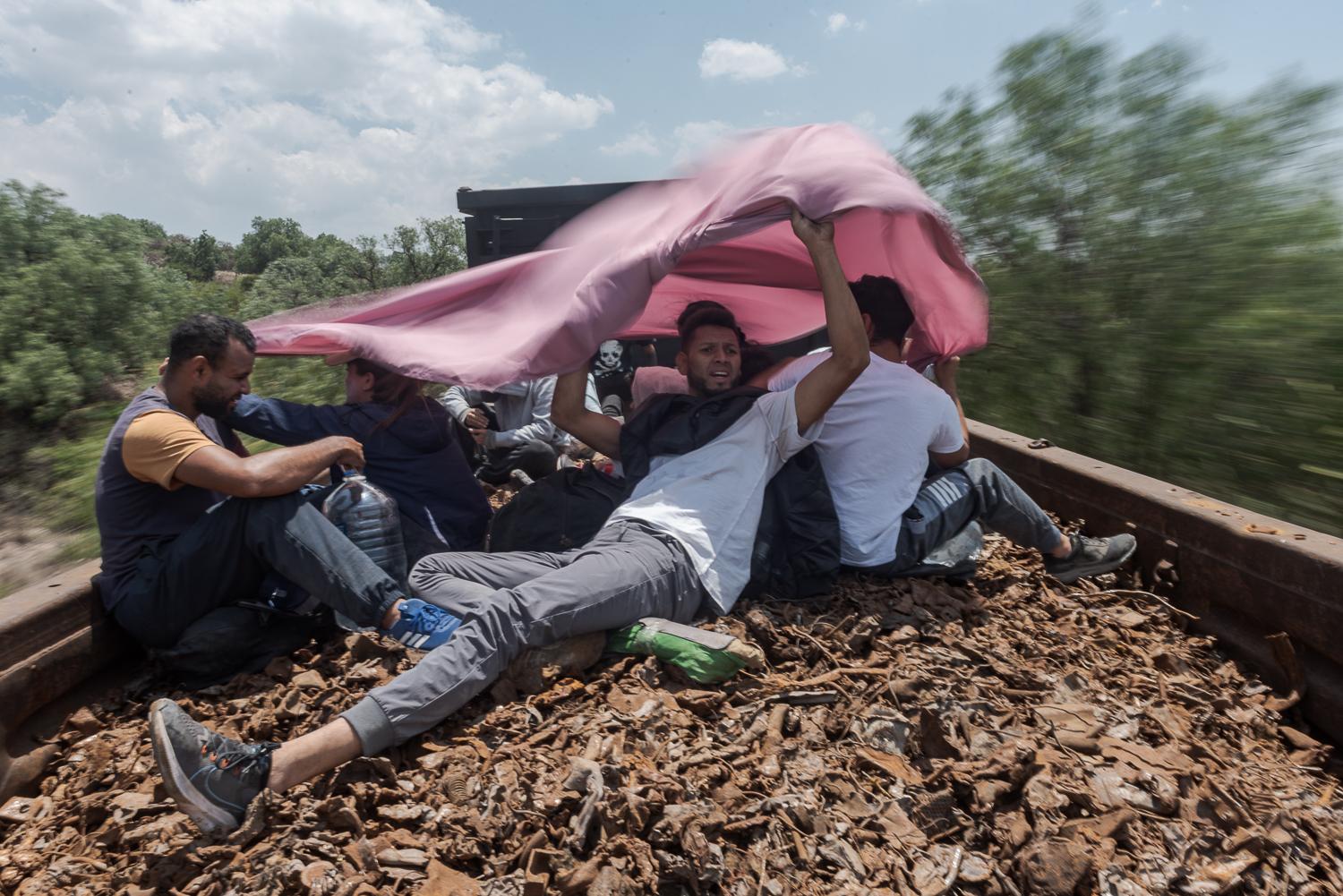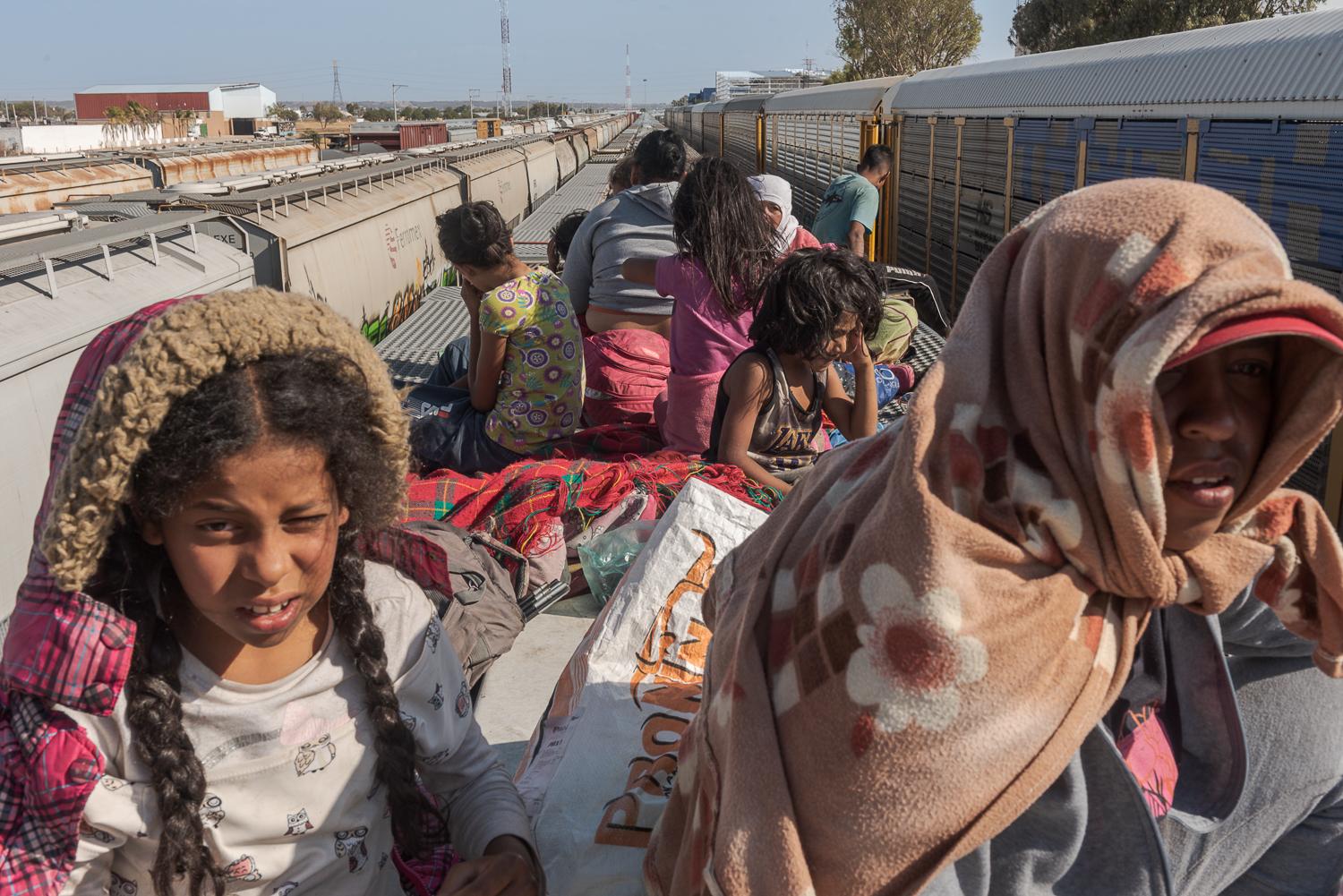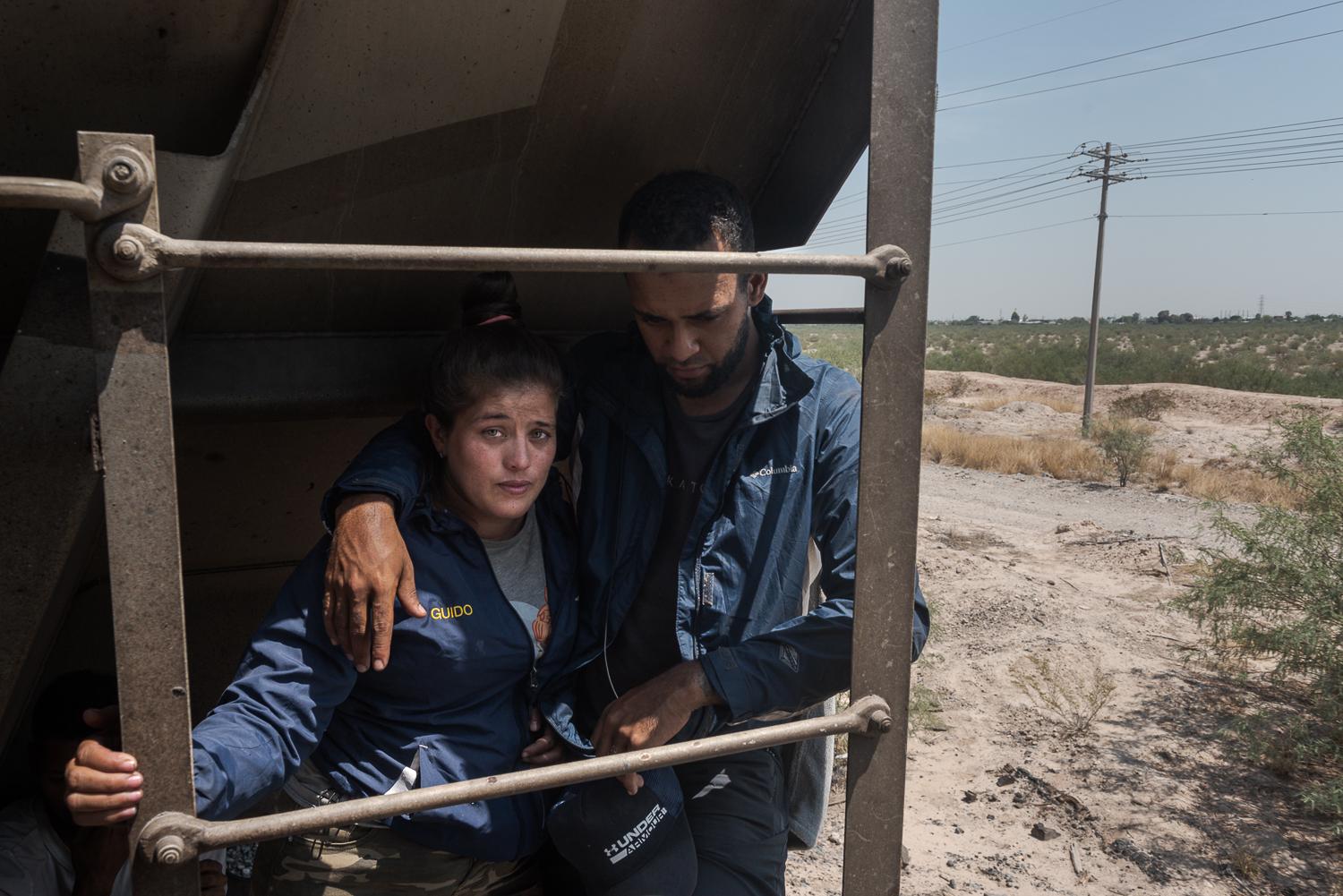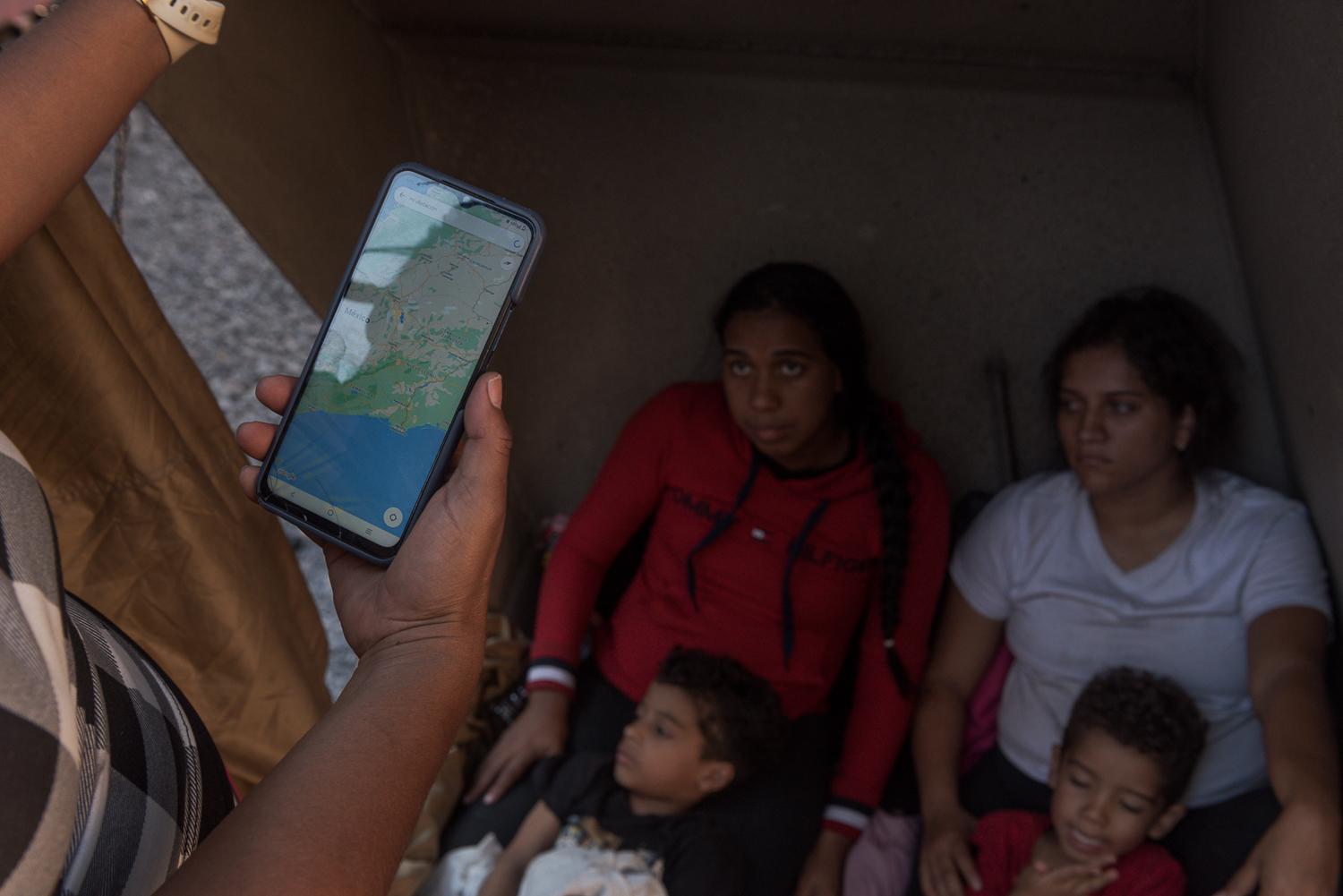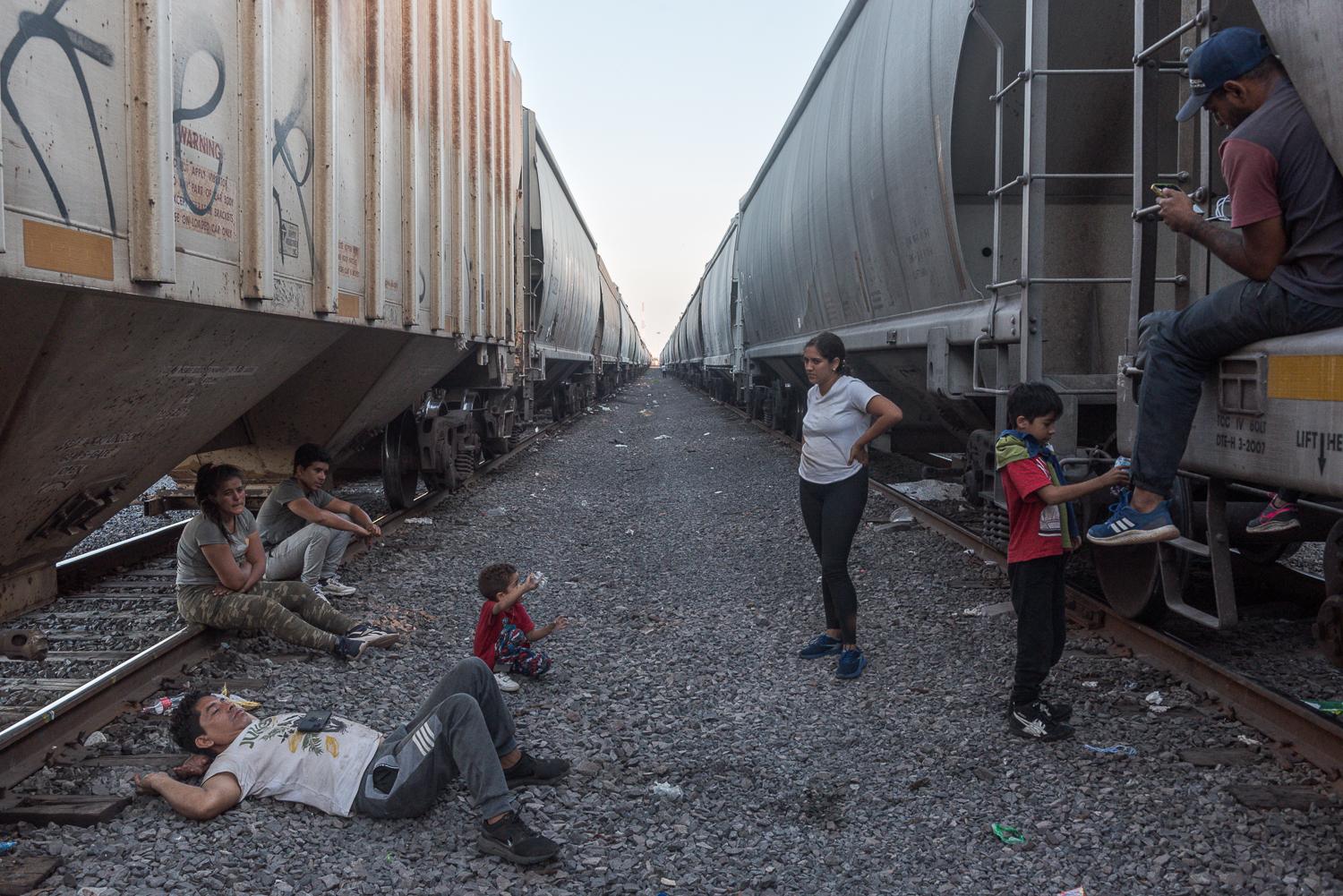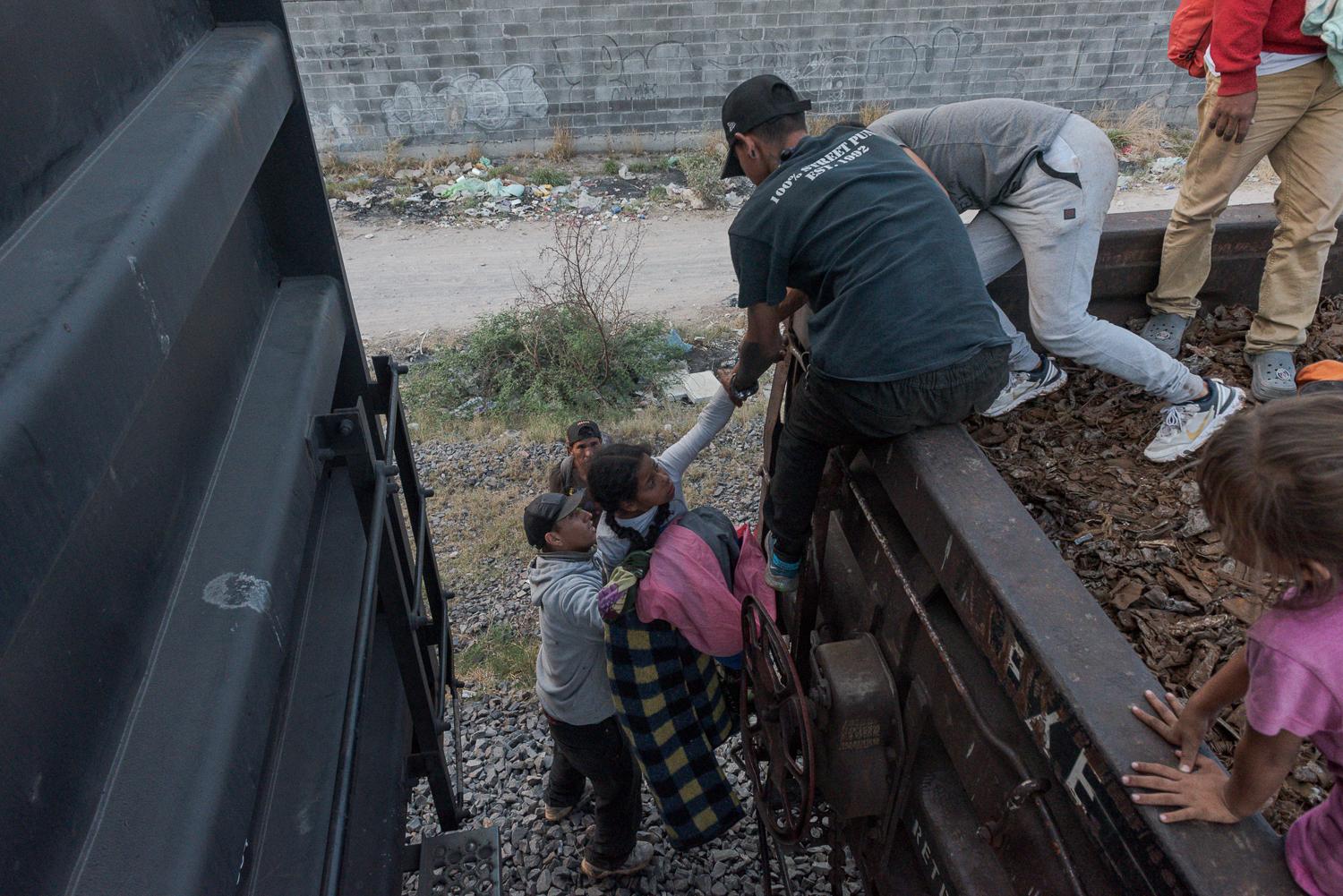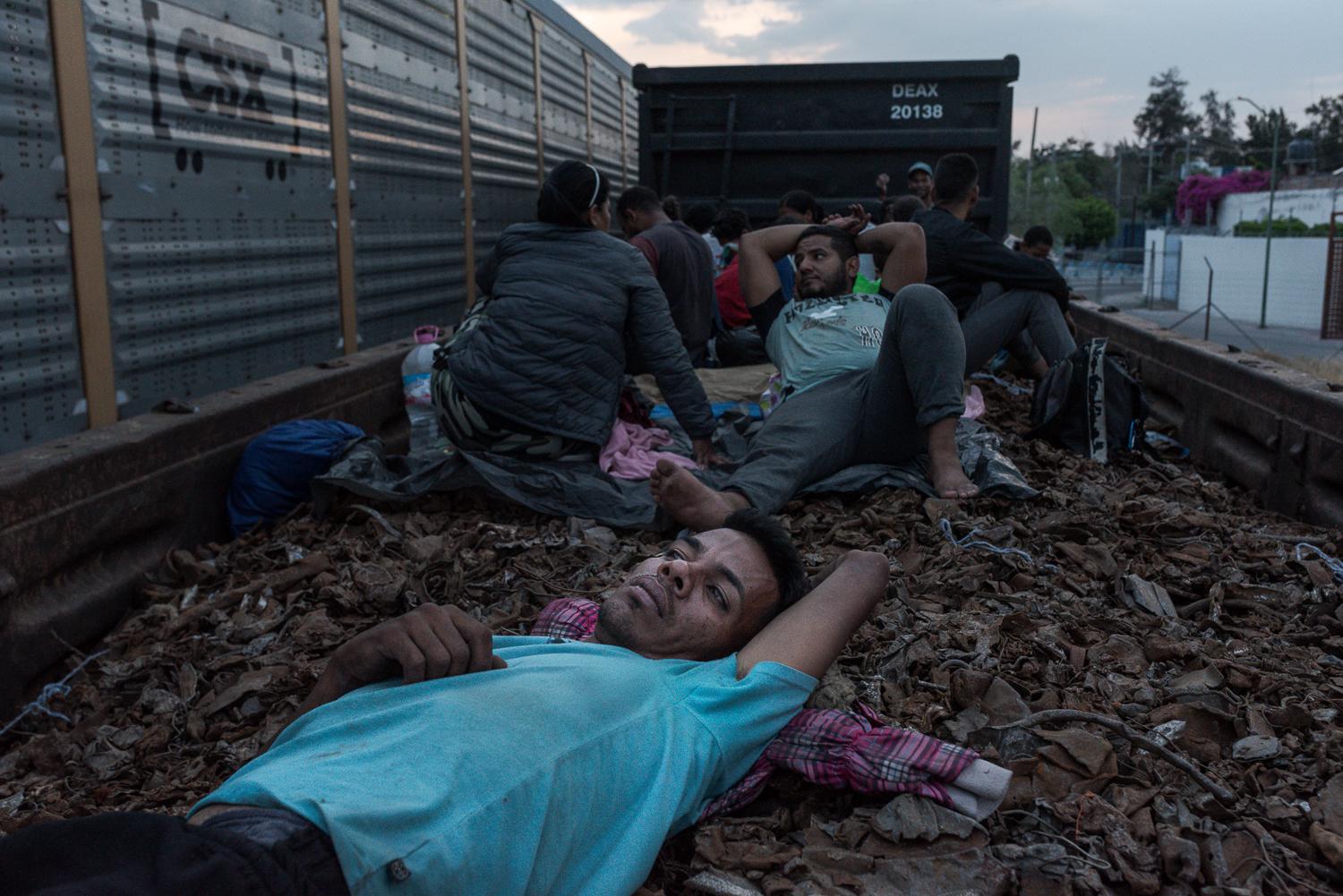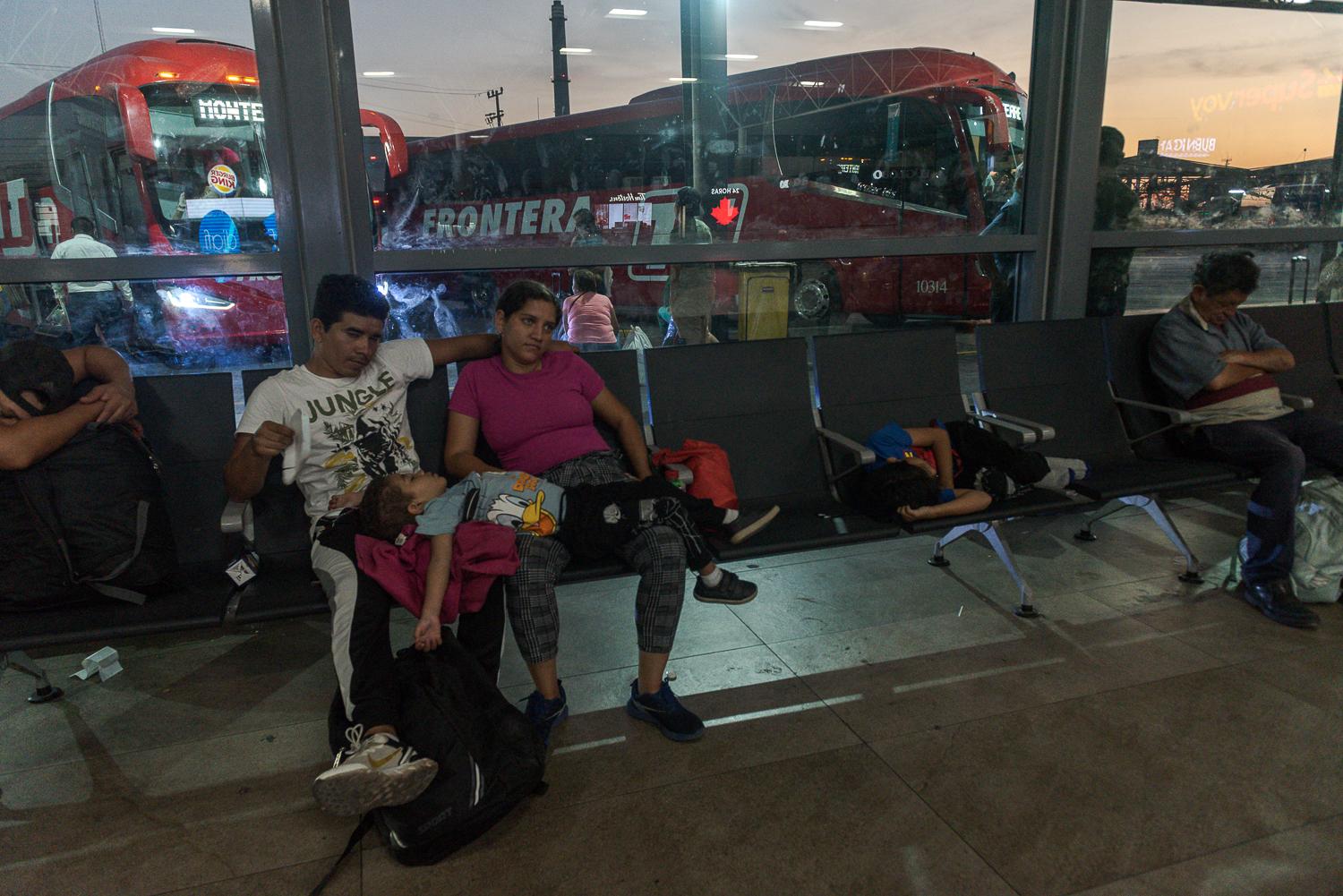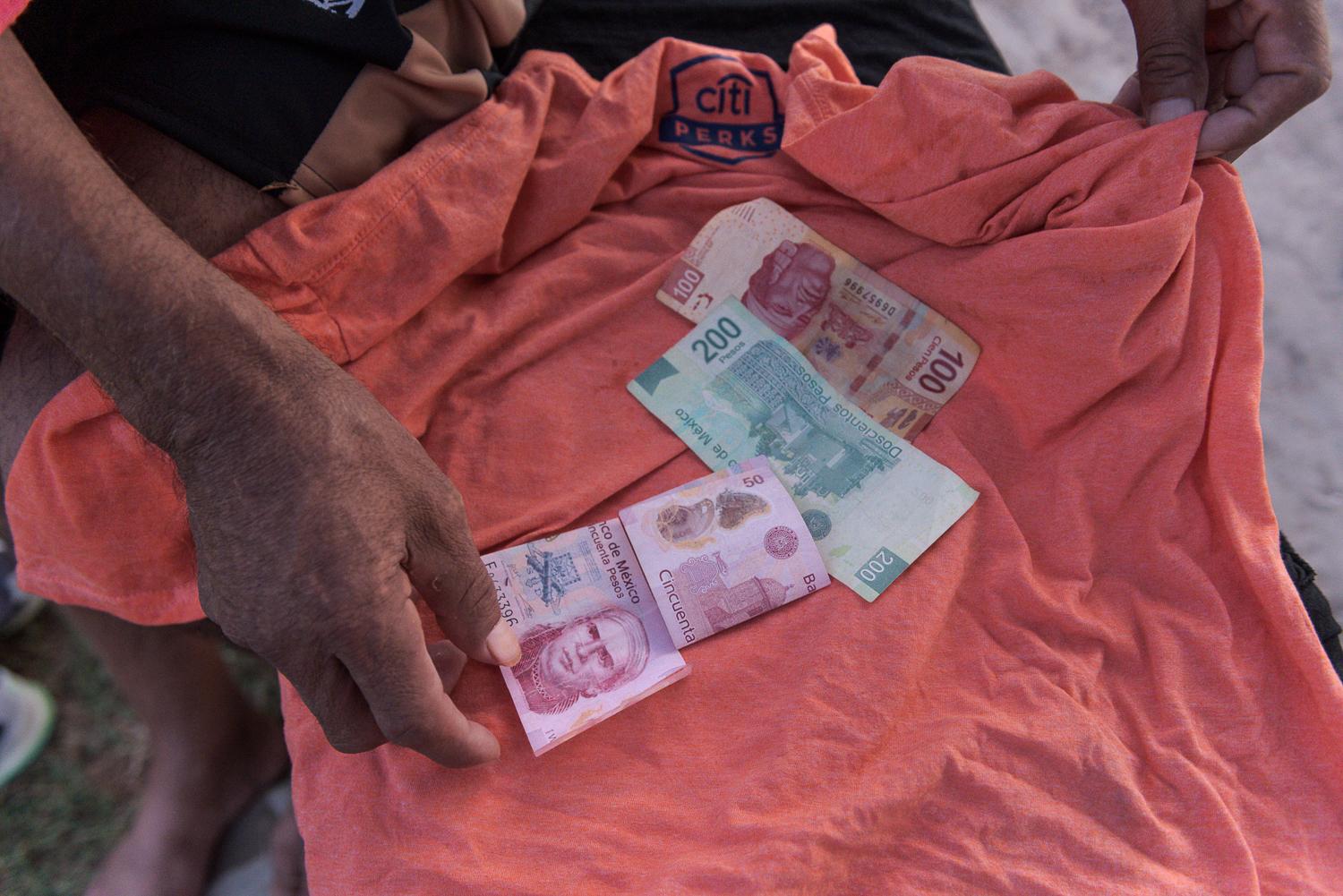La tortuosa travesía, la migración a través de América.

Israel Fuguemann
Journalist & Photographer
based in Colombia
Janayka, Mathias, Mauricio and Abraham say goodbye to Alejandra before starting their trip to the border with the United States. They are in a room in Mexico City. June 17, 2023. Mexico City Mexico
Janayka, Mathias, Mauricio and Abraham say goodbye to Alejandra before starting their trip to the border with the United States. They are in a room in Mexico City. June 17, 2023. Mexico City Mexico
Janayka and her little son Mathias are in a hotel room in Huehuetoca, the city where they wait for the arrival of the train known as "The Beast." Huehuetoca, Mexico, June 17, 2023. Mexico City Mexico
Ronny makes a prayer to his god in the morning. He is inside a hotel room, and is about to go in search of the train known as "The Beast". This means of transportation is known to be dangerous, but thousands of Latin American migrants use it to reach the border with the United States of America. In the first half of 2023, around 250,000 people made this journey through Latin America, a figure that represents, according to the IOM, the largest record of people in transit in the Western Hemisphere in all of history. Huehuetoca, State of Mexico, Mexico, June 18, 2023. Mexico City Mexico
The Peña family very early at dawn await transportation to travel to the Huehuetoca dump, the place where the freight train known as "La Bestia" stops before continuing on its way to northern Mexico. In the first half of 2023, around 250,000 people made this trip through Latin America, a figure that represents, according to the IOM, the largest record of people in transit in the Western Hemisphere in all history. Huehuetoca, Estado de Mexico. June 17, 2023. Mexico City Mexico
Little Mauricio Peña poses for a portrait while his family waits for a transport that will take them to the Huehuetoca garbage dump, where they will wait for the train known as "The Beast". In the first half of 2023, around 250,000 people made this trip through Latin America, a figure that represents, according to the IOM, the largest record of people in transit in the Western Hemisphere in all history. Huehuetoca, State of Mexico. June 17, 2023. Mexico City Mexico
The Peña family rests under the shade of a tree while watching a train go by. In the first half of 2023, around 250,000 people made this trip through Latin America, a figure that represents, according to the IOM, the largest record of people in transit in the Western Hemisphere in all history. Queretaro, Mexico. June 18, 2023. Mexico City Mexico
A family of migrants runs to board the train known as "The Beast." Huehuetoca, Mexico. June 18 2023. Mexico City Mexico
A group of people desperately seeks to get on one of the wagons of "The Beast". while the train makes a stop. This migratory route by train is recognized as one of the most dangerous in the American continent. In the first half of 2023, around 250,000 people made this journey through Latin America, a figure that represents, according to the IOM, the largest record of people in transit in the Western Hemisphere in all of history. Huehuetoca, State of Mexico, Mexico, June 17, 2023. Mexico City Mexico
Ronny holds a blanket over the family with whom he is traveling to the United States. they must endure the sun's rays while traveling on the wagons of "The Beast". In the first half of 2023, around 250,000 people made this trip through Latin America, a figure that represents, according to the IOM, the largest record of people in transit in the Western Hemisphere in all history. San Queretaro, Mexico. June 17, 2023. Mexico City Mexico
Maria and her daughters Jimena, Alana, Elier and Andri travel aboard the roof of "La Bestia". With temperatures that exceed 40 degrees centimeters during the summer, these families must endure a journey of more than 2 thousand kilometers through Mexico. In the first half of 2023, around 250,000 people made this trip through Latin America, a figure that represents, according to the IOM, the largest record of people in transit in the Western Hemisphere in all of history. Guanajuato, Mexico. June 17, 2023. Mexico City Mexico
Alejandra and Leonardo travel on the train known as "The Beast". They are very tired because they started their trip two months ago from Chile and have traveled more than 5 thousand kilometers to reach this point somewhere in the northern desert of Mexico. In the first half of 2023, around 250,000 people made this trip through Latin America, a figure that represents, according to the IOM, the largest record of people in transit in the Western Hemisphere in all history. Piedras Negras, Coahuila, Mexico. June 20, 2023. Mexico City Mexico
Janayka, Mathias, Mauricio and Abraham aboard the "La Bestia" train looking for their location within Mexico on a map. Unknown location, Mexico. June19, 2023. Mexico City Mexico
Janayka, Mathias, Mauricio and Abraham, Ricardo, Roberto, Genesis, wait at a train station in the state of Zacatecas for "The Beast" to move again to continue its journey. Zacatecas, Mexico. June19, 2023.
A group of migrants boards the "La Bestia" train in the city of Irapuato, Mexico. June 18, 2023.
A man rests on a bed of rusty metal. He is a migrant traveling on "The Beast" to the United States of America. In the first half of 2023, around 250,000 people made this trip through Latin America, a figure that represents, according to the IOM, the largest record of people in transit in the Western Hemisphere in all history. San Guanajuato, Mexico. June 17, 2023. Mexico City Mexico
The Peña family waits for a bus at the transport terminal in the city of Monterrey. The city has become one of the largest arrival points for migrants traveling to the United States. In the first half of 2023, around 250,000 people made this trip through Latin America, a figure that represents, according to the IOM, the largest record of people in transit in the Western Hemisphere in all history. Monterrey City, Mexico. June 21, 2023. Mexico City Mexico
A group of migrants sleeps on the streets of the city of Irapuato. They were stranded after traveling on the "La Bestia" train, now they wait while the next train passes by again. Many streets in the cities where migrants pass through on their journey to the United States have not been prepared to receive this new wave of migrants. Mexico City Mexico
A "coyote" shows the money he charged for crossing a family across the Rio Grande. A "coyote" is a man who charges migrants to help them cross the border into the United States of America. Piedras Negras, Mexico. June 23, 2023. Mexico City Mexico
The Peña family walks along the banks of the Rio Grande, they look for the best option to cross the river. They try to do it quickly because the border paths are dangerous due to the recurring assaults on migrants. In the first half of 2023, around 250,000 people made this trip through Latin America, a figure that represents, according to the IOM, the largest record of people in transit in the Western Hemisphere in all of history. Piedras Negras, Coahuila, Mexico. June 17, 2023. Mexico City Mexico
The Peña family: Roberto, Janayka, Mathias, Ricardo, Génesis, Mauricio and Abrahan finally cross the Rio Grande that divides Mexico and the United States of America. After traveling four thousand kilometers for two months, this Venezuelan family will try to stay and live in US territory. In the first half of 2023, around 250,000 people made this trip through Latin America, a figure that represents, according to the IOM, the largest record of people in transit in the Western Hemisphere in all of history. San Querétaro, Mexico. June 17, 2023. Mexico City Mexico
"La Bestia" mexicana.
Esta historia no comienza aquí en medio del desierto, bajo los rayos de un sol fulminante arañando los cincuenta grados centígrados en el termómetro; con la familia Peña en medio de un llanto contenido intentando cruzar el río Bravo, la frontera natural que divide a México y Estados Unidos. En realidad ésta historia comenzó cuatro mil kilómetros atrás, cuando a la par de otras miles de familias más, los Peña iniciaron una larga travesía migratoria por continente americano.
El Darién
El Tapón del Darién, unos ciento treinta kilómetros de espesa selva tropical, fue su primera gran prueba. Roberto Peña, el hermano medio de la familia, me dijo cuando nos entrevistamos en Ciudad de México, tan sólo cuatro semanas después de nuestro primer encuentro en el Darién, que la selva había sido uno de los momentos más difíciles en sus treinta años de vida.
-Nunca voy a olvidar la pregunta que me hizo mi hijo Matias mientras cruzábamos la selva: ¿Por qué me trajiste a este lugar Papá, si sabías que era peligroso? En ese momento me vine abajo, me sentí terriblemente mal y lo único que pude hacer fue llorar y pedirle perdón por lo que estábamos viviendo. Le dije la verdad, que yo no lo sabía.
El territorio comprendido entre Panamá y el sur de México, es la región más estrecha del continente americano y también una de las más pobres, corruptas y violentas del mundo. Durante los últimos cuarenta años los diversos conflictos políticos y sociales mantuvieron a Centroamérica con las tasas de homicidios per capita más altas del mundo; hasta 105 por cada 100 mil habitantes en algunos casos según datos el Banco Mundial.
Antes de llegar a la frontera sur de México, Los Peña fueron estafados, extorsionados y obligados a pagar transportes que usan caminos alternos y que son operados principalmente por coyotes y por policías que han montado distintos métodos para exigir dinero a cambio del “libre” tránsito por las zonas que los migrantes deben atravesar.
Welcome to Mexico
Al suroeste de México, existe un cuerpo acuoso que divide a México de Guatemala y que durante décadas ha sido el cruce obligado para el flujo migratorio proveniente del Sur: el río Suchiate. Allí donde para 130 millones de mexicanos “comienza la patria”, para otros miles más, inicia la segunda gran prueba de la travesía migratoria: una pesadilla llamado México.
Para intentar frenar este gran movimiento trans humano, el gobierno de los Estados Unidos de América, convenció al gobierno mexicano de convertirse en un “tercer país seguro”, así como de endurecer sus políticas migratorias para convertirlo en auténtico muro que contenga la migración hacía el Norte. Actualmente treinta mil elementos del Ejército, la Marina y Guardia Nacional mexicana vigilan la región, pero hasta ahora la migración ha demostrado que no hay fuerza pública que la detenga.
A pesar de que el actual presidente de México, Andrés Manuel López Obrador (AMLO), se auto proclama como humanista, diversas organizaciones civiles que trabajan directamente en temas de migración y derechos humanos, catalogan su administración como una de los más severas en el trato a los migrantes. El Instituto Nacional de Migración (INM) reportó casi medio millón de detenciones a migrantes irregulares y más de cien mil deportaciones en el 2022; según la OIM, el país enfrenta la mayor cantidad de personas registradas en tránsito en toda la historia en el Hemisferio Occidental.
México Trágico
Este día será era la última vez que la familia Peña estará junta después de casi dos meses de viajar acompañándose. Es un sábado al medio dentro de un pequeño apartamento en el barrio Doctores de la Ciudad de México. Al espacio lo perfuma el olor reciente de una ducha: vapor, champú y crema corporal, tal vez son falsas rosas y jazmines lo que se respira del aire. Casi todo parece estar listo, excepto ellos.
Los niños, Mathias, Mauricio y Abraham, miran atentos la televisión, mientras Ronny, Ricardo, Génesis, Roberto, Janeyka, Fran y Daniela, terminan de alistar la cosas para la última etapa de su viaje hacía el norte de México. Hay un cierto nerviosismo comunitario que es fácil de percibir: pocas palabras y mucha agitación.
El camino es largo, casi 1, 500 kilómetros hasta la frontera de Piedras Negras, Coahuila, en el noroeste mexicano; pero antes Los Peña deben enfrentarse a “La Bestia”, un conjunto de trenes que los migrantes han usado para esquivar los controles migratorios desde hace algunas décadas para llegar a los Estados Unidos.
Para montarse en “La Bestia”, lo primero hay que hacer es atravesar la capital mexicana para poder llegar a Huehuetoca, un poblado periférico a 60 kilómetros de distancia. Allí donde el tren se detiene, se alza una montaña de desechos con pútrido olores cuya única señal de vida aparente son los cientos de migrantes que arriban diariamente, obligados por transitar la clandestinidad en que se mueven.
Diariamente hay centenares de migrantes que pasan la noche en ese basurero a la espera de un tren. Hay niños, mujeres embarazadas, adultos mayores, familias enteras. La mayoría tienen el semblante y la facha de quien no la ha pasado bien. Están divididos en pequeños grupos y acomodados a los pies de unos viejos árboles, son siluetas envueltas en el humo de unas fogatas sucumbiendo ante luz matutina.
La Bestia
Antes de ser visible, esta mole de acero solido de más de dos kilómetros de largo y doscientos vagones de carga se hace sentir. El suelo retumba y un estruendo se escucha a lo lejos; es la señal inequívoca que los migrantes han esperado durante toda la noche; un pasaje sin retorno antes de poder llegar a las puertas del sueño anhelado. Los Peña corren aprisa.
Cuando el tren se detiene las personas se arremolinan sobre las escaleras de acceso; en este momento los gritos comienzan a escucharse y el caos inicia porque esta pausa durará tan sólo unos minutos. Hay mochilas, mantas y bidones de agua volando por el aire; cuerpos extendiéndose cuan largos pueden ser para alcanzar los vagones. Cuatro metros de altura los hacen ver pequeños y frágiles ante la colosal figura de la locomotora. Aquí debajo de ella su nombre cobra sentido: “La Bestia” es realmente imponente.
Una vez en marcha los gritos pasan a ser silencios incómodos, lágrimas que se tragan mientras el pasado va quedando detrás. Arriba los cuerpos se mueven cuidadosamente porque ahora buscan acomodarse en medio de la inmensa carga de metales oxidados que esta debajo de ellos; son los restos de un mundo industrial que no los necesita más, toneladas de desperdicios convertidos en una cama punzante donde ahora viajan los sueños de cientos de personas.
En los primeros kilómetros los techos de los vagones se han convertido en campamentos al aire libre que se mueven sobre rieles. Los migrantes aún no lo saben, pero el viaje será así durante todo el camino, unos 1,800 kilómetros, que si todo sale bien, se convertirán en 4 días hasta alcanzar la frontera; mientras eso pasa, tendrán que soportar hambre, deshidratación y los peligros de cruzar un país controlado por el crimen organizado en gran parte de su territorio.
El vagón de los sueños rotos
La mayoría viaja ensimismada, como buscando en la memoria las palabras para describir lo que han tenido que vivir para llegar aquí, sobre este tren que parece andar en medio de la nada; mientras delante de sus ojos se va desdibujando un país que sólo conocían por sus telenovelas y la mala publicidad de los noticieros. Visto desde aquí, México parece sólo un paisaje árido con aire desolador. Está claro, casi nadie quisiera quedarse aquí.
La ruta migratoria sobre “La Bestia” está considerada como una de las más peligrosas del mundo, año con año hay migrantes que pierden la vida y varias decenas más que resultan mutilados a causa de los accidentes abordo del tren. Es difícil establecer una cifra exacta porque los flujos son cambiantes y hay pocos registros fiables, según un informe sobre migración y discapacidad de la Cruz Roja y la Coalición México por los derechos de las personas con discapacidad (COAMEX), desde el año 2014 se han registrado casi medio millar de casos de mutilaciones de personas que migraban sobre el tren.
Además de los accidentes existen otros peligros, como asaltos y violaciones que ocurren sobre los trenes. A pesar de que los migrantes mayoritariamente lo hacen por necesidad, los delincuentes tienen la idea de que para llegar a la frontera con EU, los migrantes traen consigo dinero y pertenencias de cierto valor que los convierten en un blanco fácil, además porque saben que casi ninguno se atrevería a hacer una denuncia formal.
El desierto
Después de abandonar el centro del país, la complejidad de la geografía mexicana abre paso a una larga cadena montañosa que va escoltando a lo lejos el paso del tren; a medida que avanza lentamente sobre la inmensidad del desierto que gobierna el norte de México, el viaje más que nunca se convierte en un acto de resistencia que sólo es soportado por la fe.
Mientras Genesis mira la secuencia infinita de cactus fuera del tren, dice que nunca pensó que México fuera tan largo y recorrerlo tan difícil, que incluso la atravesar la selva del Darién fue menos complicado. -En la selva sabíamos que debíamos caminar y sobrevivir dependía de nosotros- pero aquí, hacinados sobre este vagón de tren, con el sonido ensordecedor de estas cajas metálicas en todo momento, en medio de toda esa nada, siente que sus vidas ya no dependen sólo de ellos, “ahora sólo Dios sabe”.
Sin señal telefónica es difícil ubicar una posición en el mapa, podría ser cualquier lugar, después de tantas horas de andar todo parece lo mismo y nada de lo que pasa más allá de estos barrotes métalicos parece tener importancia. Cuando trece personas viajan en un espacio tan reducido la travesía se hace tediosa; los niños lloran de vez en cuando y el hambre, la deshidratación y la claridad mental son cada vez más frágiles.
Antes de caer la oscuridad el tren hace una parada rutinaria, es una vieja estación de trenes. Ninguna casa, ninguna señal de vida, sólo viejos vagones alrededor y un muro recientemente pintado que dice así: Zacatecas. Los migrantes aprovechan para bajar del tren, estirar el cuerpo; son decenas de ellos viajando en las mismas condiciones, la misma triste estampa en cada vagón.
Cambio de planes
Fue larga la noche, y al amanecer no mucho ha cambiado, el desierto sigue ahí, el cansancio, el hambre y la sed también. El calor vuelve, para el medio día ya ha superado los cuarenta y cuatro grados centígrados y el próximo destino que parecía inalcanzable aparece después de de doce horas; se llama Torreón y es la capital del Estado de Coahuila. La familia Peña no puede más, los niños se encuentran en malas condiciones y ninguno quiere continuar en La Bestia, “viajar así no es humano”.
Hay un cambio de planes, es arriesgado pero es la única opción posible. El grupo decide viajar por una línea de autobuses comerciales hacía la ciudad de Monterrey, arriesgándose a ser detenidos por los agentes migratorios. Aún así deciden arriesgar dos meses de viaje, y todo el dinero invertido, alrededor de tres mil dólares por familia, el resultado de haber vendido todo cuanto tenían antes de migrar.
Tras varios intentos, una sola línea de autobuses accede a vender los boletos, así los Peña suben a un transporte que después de lo vivido parece más lujoso de lo que en realidad es: un simple camión de paso. En la estación de autobuses de Monterrey, la situación no es menos dramática, hay cientos de migrantes como los Peña buscando llegar a la frontera. La salas están repletas de familias durmiendo en el suelo, a las afueras de la terminal, donde sea que encuentren un espacio para reposar.
La frontera
Piedras Negras es una ciudad discreta: un río, un par de puentes, algunos hoteles, negocios de comida Tex-Mex y unas cuantas cantinas que destacar. Su nombre se lo debe a los antiguos yacimientos de carbón en la región y su fama a la violencia y al tráfico de drogas, migrantes y armas de los último años. Su importancia para México radica en que es uno de los 40 cruces migratorios que existen a los largo de los 3,185 km de línea fronteriza con Estados Unidos y millones de personas lo usan para cruzar año con año.
La migración irregular en la ciudad ha sido constante, pero poca y silenciosa en comparación a otras fronteras del país; desde que el flujo de migrantes provenientes de Sudamerica aumentó, en Piedras Negras es cada vez más común encontrar gente que camina a pasos apresurados por las calles y siempre en dirección al norte.
Eagle Pass, Texas, la pequeña ciudad otro lado del río, tiene diez veces menos población que Piedras Negras, apenas 25 mil habitantes y sus autoridades no pueden ocultar su preocupación por la gran cantidad de migrantes que a diario están cruzando el río ilegalmente. Para tratar de impedir su paso el gobierno ultra conservador de Greg Abbott en Texas, designó cerca de cuatro mil elementos de seguridad para custodiar el borde fronterizo; además de colocar diversos tipos de obstáculos como alambres de púas y bollas punzo cortantes a lo largo del río.
Good Bye México
Cuando el autobús en el que viajan Roberto, Janayka, Ricardo, Genesis y sus hijos llega a Piedras Negras, el termómetro casi alcanza los cincuenta grados centígrados; en este desierto incluso caminar se hace proeza. Para llegar al río fronterizo, la familia usa uno de los tantos “coyotes” o “polleros” que rondan por la ciudad.
El traficantes que también es taxista, los transporta a una calle cercana al río Bravo y desaparece rápidamente con 100 dólares más en su bolsillo. Como en una obra teatral muchas veces ensayada de repente entra en escena otro estafador que dice ser un “agente migratorio del gobierno encubierto”. El hombre habla e intimida con el discurso de la deportación. Sin tiempo para pensar en nada, todo parece perdido.
Los niños comienzan a llorar; Roberto y Ricardo intentan explicarle todo lo que han hecho para conseguir estar allí, en la frontera, al lado del río, frente a él, pero parece que nada de eso da resultado. El hombre exige el dinero para dejarlos pasar.
El miedo, la angustia y la desesperación provocan que el pequeño Mauricio se arrodille frente al supuesto “agente encubierto” y suplique. -Por favor señor, no nos lleve, déjenos pasar, se lo suplico, no nos haga nada- La imagen del pequeño de apenas siete años, arrodillado y suplicando frente este hombre, insinuando que su travesía para llegar a Estados Unidos está apunto de fracasar, es demoledora.
Después de entregar el último dinero que tenían el hombre los deja avanzar y tras un par de minutos caminando entre los matorrales finalmente los Estados Unidos dejan de ser un lugar en la imaginación y se hace un lugar visible. Al otro lado del río unos guardias armados en un vehículo de la Patrulla Fronteriza de los Estados Unidos vigilan el lugar.
Roberto, Janayka, Ricardo, Genesis, Matias, Abraham y Mauricio, comienzan a sumergirse en el río, caminando uno tras de otro en medio de un llanto contenido, mientras una ola de sentimientos se les vienen encima. Quizás, finalmente tras esa valla metálica podrán encontrar el futuro prometedor con el que han soñado a los largo de tanto tiempo y tantos kilómetros a través de su larga travesía por el continente americano.


